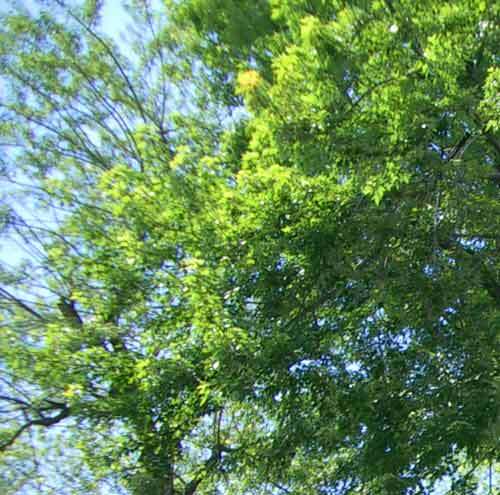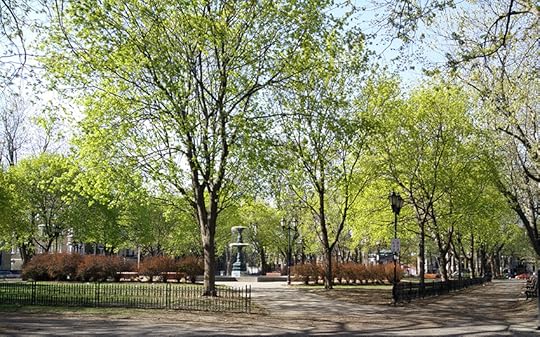Elizabeth Adams's Blog, page 49
June 5, 2015
Verdant, Shining
We were in central New York for the past few days, visiting my father, staying at the lake where I grew up. Early on the last morning, a deer walked slowly across the grass near the house, on her way to the water's edge, stopping to graze now and then, lifting her head to sniff and listen. We hardly ever see deer so close to the house, so I was surprised and grateful. I had been feeling sad to be leaving, and this beautiful animal felt like a sign to me that all was well, all would be well.
A little while later I went out to see if she was still there. The deer had disappeared, like the apparition she seemed to be, but the morning light was extraordinary as the mist blew across the water.
Someone had already had their breakfast:
And thousands of miniature worlds hung suspended in the dew.
The day before we had driven to Cooperstown with my father and his friend, through the green hills...
...and fields where the corn was just emerging.
We saw a lot of wildlife. Flocks of geese in the fields, and on the water with many goslings. Delicate wild bunnies. Herons and hawks. Skunks and woodchucks. Lots of deer. Wild turkeys. And even a gloriously blue bluebird.
And here's Dad and me at our destination: that most American and summer-celebratory of institutions, the Baseball Hall of Fame, with a couple of pretty good hitters behind us.
It's hard to believe, but even though I've been in Cooperstown countless times - I practically lived there one winter long ago - I'd never been to the BHoF before. We had fun. And were sorry to just miss meeting up with Phoenicia author and good friend Marly Youmans, who lives nearby. Next time!
May 28, 2015
Northern New England
A diary entry from a week ago:
Yesterday was sunny and I lay on my back on a warm rock near one of those big perfect maple trees that grow alone near houses. The sun was so bright against the white New England clapboards it made my eyes water. Above me were lazy summer clouds and high, high up, swallows playing in the wind. The air smelled like lilacs and grass; redwing blackbirds argued in the trees and a solitary cricket sang under the porch. It was as if my former life were colliding with the present one: all the sensory impressions were as familiar and readable as my own skin, while my actual self seemed to be elsewhere. I felt like a ghost.
May 23, 2015
May 23
Thinking of my beautiful, beloved mother today, who left us nine years ago. This photograph was taken in 1974, when she was 50.
And, as has become my ritual (here and here) I made a drawing as a way of remembering her, incorporating lilies-of-the-valley and one of her Wedgewood pots. This one also includes three Mexican palm-leaf fishes, made by the Nahuatl for Palm Sunday.
May 17, 2015
African violet
In my memory, my grandmother sits knitting in a sunny bay window surrounded by her African violets. I wonder how many she had - fifty? - and they were always in excellent condition, blooming happily. Every month of so she would put newspapers on the big dining room table and transfer all the little pots over there for inspection, trimming, repotting if necessary. Some of the violets were on shelves in the windows, but there was also a Victorian multi-tiered iron plant stand with many swiveling arms that held some of her favorites.
In the winters, when she and my grandfather went to Florida for a couple of months, my mother and I would be in charge of watering the plants. As a little girl I remember wanting to help, but being given precise instructions about watering sparingly and only from the bottom, and never spilling water on the leaves. The special pots had wicks in the base that soaked up water slowly from the saucers to prevent -- I guess -- overwatering and root or crown rot. I was allowed to help, but always did it seriousness and a certain amount of trepidation. As a result I grew up thinking of African violets as fussy old lady plants and not very desirable. Though I certainly inherited my grandmother's green thumb, I've never yet had an African violet in my house.
That changed last week when we received this temporary visitor to care for while its owners are in Europe. Not only did it ask to have its portrait drawn, I think it's also telling me it's time to break down and get one or two of my own to fuss over, now that I'm clearly becoming an, ahem, older Victorian lady myself.
Oddly, they remind a bit of one of my most favorite woodland flowers of all, the hepatica. The leaves aren't similar, but the form and soft colors of the flower have an affinity. Better yet, they bloom all year round.
I just learned that African violets belong to the intriguingly-named genus Saintpaulia, are native to the cloud forests of Tanzania and Kenya, and that some of the species are endangered or threatened. They range from "micro" (3 inches or less in diameter) to "giant" (12-16 inches). Here's how they came to the attention of European botanists:
The genus is named after Baron Walter von Saint Paul-Illaire (1860–1910), the district commissioner of Tanga province who discovered the plant in Tanganyika (now Tanzania) in Africa in 1892 and sent seeds back to his father, an amateur botanist in Germany. Two British plant enthusiasts, Sir John Kirk and Reverend W.E. Taylor, had earlier collected and submitted specimens to the Royal Botanic Gardens, Kew, in 1884 and 1887 respectively, but the quality of specimens was insufficient to permit scientific description at that time. The genus Saintpaulia, and original species S. ionantha, were scientifically described by H. Wendland in 1893.
And I guess it's true about spilling water on the leaves:
Saintpaulias are highly sensitive to temperature changes, especially rapid leaf cooling. Spilling cold water on African violet leaves causes discoloration. This is thought to be because rapid leaf cooling causes cell vaculole collapse in the palisade mesophyll cells.
OK! I stand twice forewarned.
May 15, 2015
Art Therapy
I've been a bit laid up with more dental stuff, about which the less said the better, but I've been whiling away the healing time with some drawing. We had a bouquet of tulips and early iris from my garden that were spent, but still interesting, so they became my subject today.
Nothing too exciting, but that's just fine: sometimes the purpose of art or music or books is to distract us and allow a focus on something entirely absorbing and different. I'm grateful I have those things in my life, and glad I've learned to use them that way. I'm expecting to be back to my normal routine in a few days, but it hasn't been bad to spend some time at home doing this, too.
May 12, 2015
Self in Mexico, Reflected
1.
2.
3.
4.
5.
6.
Being a bit more involved with Flickr and looking at a lot of photography this year has made me somewhat more intentional and thoughtful about my own efforts in the medium. Because I live with a professional who's so skilled and talented, I've never taken my own photography all that seriously, though it's been a big part of this blog forever. This time in Mexico I was less interested in simply recording what I was seeing - though I did quite a bit of that, of course - and found myself being more experimental about making images, as well as looking for series of things that might make interesting blog posts.
I'm fascinated with surfaces, and complex visual fields. Mexico City offers more visual richness and complexity than any place I've ever been, and I think I was trying to capture that feeling in the images I took. Somewhere around the midpoint of the trip I realized I was making a series of reflected self-portraits; some are more successful than others but I think all of them say something about what was happening there with my eyes, brain, heart. My personal favorite of these is the one at the bottom, taken in the outdoor garden at the Museum of Anthropology. What do you think?
1. Ladies' room mirror at a restaurant
2. Parque Chapultepec
3. Anthropology Museum
4. Waiting for Metrobus
5. Street level window, National Gallery of Art
6. Anthropology Museum
May 7, 2015
Tremulous
Some plants went outside on Tuesday. I had my coffee on the terrace, accompanied by sketchbook and watercolors.
In the parks, the trees are fairly quivering with every shade of pale green. (Parc Lafontaine above, Parc St-Louis below.)
While downtown, things are further along, with even the tulips in bloom. This is Phillips Square.
It's hard to describe the tenderness of a far-northern spring -- and how short-lived it can be. Spring arrived practically overnight, and is giving way to summer within one week. Leaves that were tight buds last weekend have unfurled; the magnolias have burst into bloom; tulips are lapping the daffodils in what is usually a much longer marathon of floral pacing and endurance. It's almost too much, after such an impossible winter; Montrealers are walking around looking dazed, dazzled, relieved, and somewhat uncomprehending. As for me, I'm thrilled to be back on my bike, back on the terrace, and back with my human and floral friends at the community garden, which opened last Sunday. Picnics with friends! Outdoor sketching! Birdwatching along the river! Cutting flowers for the house...just lying in the sun...such expansive possibilities!
May 4, 2015
Palms
April 30, 2015
All the Words
It's always such a pleasure to hold a new Phoenicia book in my hands, knowing that the author's work has been put into print for present-day readers and for posterity, and that I've played a role in making that happen.
I first became aware of Magda Kapa through our mutual friend Teju Cole, and began reading her blog ("I Was Not Born in English") and following her on Twitter, where she was quite active and experimental, writing short poems and aphorisms, or short sayings/definitions. We left each other comments, and gradually became friends, with her Greek heritage and my classicist background as another connection.
She writes:
"In 2013 I spent a whole year on Twitter exploring the meaning of “big” words like life, death, love, sex, pain, pride, violence, hope… When I started writing these “definitions” in January that year, I had no idea they’d become a project. I had just entered a period in my life where reflection and its creative documentation not only felt necessary but became my life’s red thread. A thread far from following a straight line, though, but mostly curling into circles that only slowly, if at all, formed a moving spiral. Most of the words escaped permanent definitions; life kept, and keeps, redefining them for me."
This project, named "All the Words," became a journal of aphorisms, short sayings, epigrams, and "naked verses." Poet and translator George Szirtes was one of thousands of readers captivated by Magda Kapa's project, and praised her writing as "the pared-down core of poetry;" Dave Bonta stated that Magda Kapa is "a master of the aphorism" and that her book will be on his shelf along with classics of Chinese, Hebrew, and Sufi literature.
Eventually, Magda approached me about the possibility of turning "All the "Words" into a printed book. I read and re-read the manuscript, and we talked. Magda described the manuscript as a Heraclitian river, and I liked that: the term comes from the pre-Socratic Greek philosopher Heraclitus, who said "No man ever steps in the same river twice." Although Magda revisited many words in the course of a year, life kept redefining them for her. In my page design for the book, I tried to keep this sense of constant change, and Magda's "moving spiral" was the inspiration for the calligraphic painting I did for the cover.
Here's a look inside:
Several of you have already ordered the book and we appreciate that very much. I hope some other Cassandra readers, too, may want to dip into the ever-changing river of Magda Kapa's thoughts: it has certainly helped me find new ways of considering my own relationship to the everyday words with which we define our lives and their movement through time.
Furthermore, please know that your support of a book like this encourages the sort of experimentation and creativity that mainstream publishers have almost completely abandoned. I think it's crucial for all of us who care about language in general, and poetry in particular, to support writing that breaks new ground, uses non-traditional media, and expands our awareness of how our minds work with words.
ALL THE WORDS is only available through direct order from Phoenicia, and we are able to ship it anywhere for very reasonable prices.
April 28, 2015
Back, But Still in Transition
Back to the mail. Watercolor and ink. 4/20/2015
It's great to travel, and good to come home, but sometimes it's harder than others to pick up the threads of where you were a few weeks ago, or a month ago, and start in again. For some reason, it's not been particularly easy for me to jump back into my life as it was -- the mail, the taxes, the accounting, the book business. I've done what I needed to do, but I feel like my mind is partially elsewhere. Because of J.'s exhibition, we had a lot to do right after getting back from Mexico City, and I haven't had time yet to work on my photos or even think about the trip very much, let alone write about it. It's more than that, though. I was thinking about what I wanted to do next before I ever left, about some changes in my internet use, and in my daily life. Some of those questions have been answered, and some continue to loom unresolved in the back of my head, but more pressingly now because my schedule is finally more open. That's always the case, isn't it? We long for space -- time -- freedom, and then when summer vacation, or retirement, or even that free weekend arrives, we don't find it so easy to act decisively and take advantage of it to do what we thought we wanted to.
Desk with pink gift boxes. Watercolor and ink, 4/27/2015.
I feel a bit like this jumble on my desk, which is probably why I drew it last night. There are some precious things here that I wouldn't part with; some obsolete or broken items that need to be thrown out; evidence of work in progress; and some recent gift boxes: pretty but empty.
When we return from time away, we also notice things we had ignored. I've got a lot of stuff that needs to be cleaned up, straightened out, and actually it feels like I need to do that before starting any new big projects. I'm talking more about real things, practical things like my desk, but there's probably head-stuff as well. And it's almost spring, even here in the far north where it has taken forever to arrive. It's the opposite of the way it should be, but spring is always the hardest time of year for me, when I'm the most likely to feel a bit depressed. So it's time to get outside, continue the exercising that's been helping me get through these interminable end-of-winter days, play the piano, draw, clean the terrace, and not be too hard on myself. You heard it here!










































